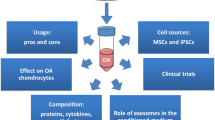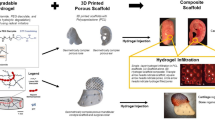Abstract
We have investigated whether 5% oxygen tension (O2) is beneficial for neocartilage formation when chondrocytes are cultured in transwell-COL inserts. Six million bovine primary chondrocytes were cultured in an insert with DMEM supplemented with 10% fetal bovine serum and antibiotics, with or without glucosamine sulphate (GS) in a 5% or 20% O2 environment for 2, 4, or 6 weeks. The samples were collected for the histological staining of proteoglycans (PGs) and type II collagen, quantitative reverse transcription with the polymerase chain reaction (RT-PCR) analyses of the mRNA expression of aggrecan and procollagen α1(II), procollagen α2(I) and hyaluronan synthase 2, quantitation of PGs, and agarose gel electrophoresis. Neocartilage produced at 20% O2 appeared larger than that at 5% O2. Histological staining showed that more PGs and type II collagen and better native cartilage structure were produced at 20% than at 5% O2. The thickness of neocartilage increased during the culture period. Quantitative RT-PCR showed that the procollagen α1(II) mRNA expression level was significantly higher at 20% than at 5% O2. However, no significant difference in gene expression and PG content was found between control and GS-treated cultures at either 20% or 5% O2. Thus, in contrast to monolayer cultures, engineered cartilage from scaffold-free cultured chondrocytes at 20% O2 produced better extracellular matrix (ECM) than that at 5% O2. PGs were mainly large. Exogenous GS was not beneficial for the ECM in scaffold-free chondrocyte cultures.




Similar content being viewed by others
References
Adesida AB, Grady LM, Khan WS, Hardingham TE (2006) The matrix-forming phenotype of cultured human meniscus cells is enhanced after culture with fibroblast growth factor 2 and is further stimulated by hypoxia. Arthritis Res Ther 8:R61
Bassleer C, Gysen P, Bassleer R, Franchimont P (1988) Effects of peptidic glycosaminoglycans complex on human chondrocytes cultivated in three dimensions. Biochem Pharmacol 37:1939–1945
Bosnakovski D, Mizuno M, Kim G, Takagi S, Okumura M, Fujinaga T (2006) Chondrogenic differentiation of bovine bone marrow mesenchymal stem cells (MSCs) in different hydrogels: influence of collagen type II extracellular matrix on MSC chondrogenesis. Biotechnol Bioeng 93:1152–1163
Coyle CH, Izzo NJ, Chu CR (2009) Sustained hypoxia enhances chondrocyte matrix synthesis. J Orthop Res 27:793–799
Derfoul A, Miyoshi AD, Freeman DE, Tuan RS (2007) Glucosamine promotes chondrogenic phenotype in both chondrocytes and mesenchymal stem cells and inhibits MMP-13 expression and matrix degradation. Osteoarthritis Cartilage 15:646–655
Dodge GR, Jimenez SA (2003) Glucosamine sulfate modulates the levels of aggrecan and matrix metalloproteinase-3 synthesized by cultured human osteoarthritis articular chondrocytes. Osteoarthritis Cartilage 11:424–432
Egli RJ, Bastian JD, Ganz R, Hofstetter W, Leunig M (2008) Hypoxic expansion promotes the chondrogenic potential of articular chondrocytes. J Orthop Res 26:977–985
Farndale RW, Buttle DJ, Barrett AJ (1986) Improved quantitation and discrimination of sulphated glycosaminoglycans by use of dimethylmethylene blue. Biochim Biophys Acta 883:173–177
Fenton JI, Chlebek-Brown KA, Peters TL, Caron JP, Orth MW (2000a) The effects of glucosamine derivatives on equine articular cartilage degradation in explant culture. Osteoarthritis Cartilage 8:444–451
Fenton JI, Chlebek-Brown KA, Peters TL, Caron JP, Orth MW (2000b) Glucosamine HCl reduces equine articular cartilage degradation in explant culture. Osteoarthritis Cartilage 8:258–265
Fermor B, Christensen SE, Youn I, Cernanec JM, Davies CM, Weinberg JB (2007) Oxygen, nitric oxide and articular cartilage. Eur Cells Mater 13:56–65
Frenkel SR, Di Cesare PE (2004) Scaffolds for articular cartilage repair. Ann Biomed Eng 32:26–34
Galois L, Hutasse S, Cortial D, Rousseau CF, Grossin L, Ronziere MC, Herbage D, Freyria AM (2006) Bovine chondrocyte behaviour in three-dimensional type I collagen gel in terms of gel contraction, proliferation and gene expression. Biomaterials 27:79–90
Grande DA, Halberstadt C, Naughton G, Schwartz R, Manji R (1997) Evaluation of matrix scaffolds for tissue engineering of articular cartilage grafts. J Biomed Mater Res 34:211–220
Hayes AJ, Hall A, Brown L, Tubo R, Caterson B (2007) Macromolecular organization and in vitro growth characteristics of scaffold-free neocartilage grafts. J Histochem Cytochem 55:853–866
Hirao M, Tamai N, Tsumaki N, Yoshikawa H, Myoui A (2006) Oxygen tension regulates chondrocyte differentiation and function during endochondral ossification. J Biol Chem 281:31079–31092
Holmdahl R, Rubin K, Klareskog L, Larsson E, Wigzell H (1986) Characterization of the antibody response in mice with type II collagen-induced arthritis, using monoclonal anti-type II collagen antibodies. Arthritis Rheum 29:400–410
Hua J, Sakamoto K, Nagaoka I (2002) Inhibitory actions of glucosamine, a therapeutic agent for osteoarthritis, on the functions of neutrophils. J Leukoc Biol 71:632–640
Ilic MZ, Martinac B, Handley CJ (2003) Effects of long-term exposure to glucosamine and mannosamine on aggrecan degradation in articular cartilage. Osteoarthritis Cartilage 11:613–622
Irie Y, Mizumoto H, Fujino S, Kajiwara T (2008) Reconstruction of cartilage tissue using scaffold-free organoid culture technique. J Biosci Bioeng 105:450–453
Katopodi T, Tew SR, Clegg PD, Hardingham TE (2009) The influence of donor and hypoxic conditions on the assembly of cartilage matrix by osteoarthritic human articular chondrocytes on Hyalograft matrices. Biomaterials 30:535–540
Khan IM, Evans SL, Young RD, Blain EJ, Quantock AJ, Avery N, Archer CW (2011) Fibroblast growth factor 2 and transforming growth factor β1 induce precocious maturation of articular cartilage. Arthritis Rheum 63:3417–3427
Mayer-Wagner S, Schiergens TS, Sievers B, Docheva D, Schieker M, Betz OB, Jansson V, Muller PE (2010) Membrane-based cultures generate scaffold-free neocartilage in vitro: influence of growth factors. Tissue Eng Part A 16:513–521
Miyazaki T, Miyauchi S, Matsuzaka S, Yamagishi C, Kobayashi K (2010) Formation of proteoglycan and collagen-rich scaffold-free stiff cartilaginous tissue using two-step culture methods with combinations of growth factors. Tissue Eng Part A 16:1575–1584
Mroz PJ, Silbert JE (2003) Effects of [3H]glucosamine concentration on [3H]chondroitin sulphate formation by cultured chondrocytes. Biochem J 376:511–515
Mroz PJ, Silbert JE (2004) Use of 3H-glucosamine and 35S-sulfate with cultured human chondrocytes to determine the effect of glucosamine concentration on formation of chondroitin sulfate. Arthritis Rheum 50:3574–3579
Murdoch AD, Grady LM, Ablett MP, Katopodi T, Meadows RS, Hardingham TE (2007) Chondrogenic differentiation of human bone marrow stem cells in transwell cultures: generation of scaffold-free cartilage. Stem Cells 25:2786–2796
Nagai T, Sato M, Furukawa KS, Kutsuna T, Ohta N, Ushida T, Mochida J (2008) Optimization of allograft implantation using scaffold-free chondrocyte plates. Tissue Eng 14:1225–1235
Park K, Huang J, Azar F, Jin RL, Min BH, Han DK, Hasty K (2006) Scaffold-free, engineered porcine cartilage construct for cartilage defect repair—in vitro and in vivo study. Artif Organs 30:586–596
Pavelka K, Gatterova J, Olejarova M, Machacek S, Giacovelli G, Rovati LC (2002) Glucosamine sulfate use and delay of progression of knee osteoarthritis: a 3-year, randomized, placebo-controlled, double-blind study. Arch Intern Med 162:2113–2123
Pittenger MF, Mackay AM, Beck SC, Jaiswal RK, Douglas R, Masca JD, Moorman MA, Simonetti DW, Craig S, Marschak DR (1999) Multilineage potential of adult human mesenchymal stem cells. Science 284:143–147
Pulkkinen HJ, Tiitu V, Valonen P, Jurvelin JS, Lammi MJ, Kiviranta I (2010) Engineering of cartilage in recombinant human type II collagen gel in nude mouse model in vivo. Osteoarthritis Cartilage 18:1077–1087
Qu CJ, Karjalainen HM, Helminen HJ, Lammi MJ (2006) The lack of effect of glucosamine sulphate on aggrecan mRNA expression and (35)S-sulphate incorporation in bovine primary chondrocytes. Biochim Biophys Acta 1762:453–459
Qu CJ, Jauhiainen M, Auriola S, Helminen HJ, Lammi MJ (2007) Effects of glucosamine sulfate on intracellular UDP-hexosamine and UDP-glucuronic acid levels in bovine primary chondrocytes. Osteoarthritis Cartilage 15:773–779
Qu CJ, Pöytäkangas T, Jauhiainen M, Auriola S, Lammi MJ (2009) Glucosamine sulphate does not increase extracellular matrix production at low oxygen tension. Cell Tissue Res 337:103–111
Rajpurohit R, Koch CJ, Tao Z, Teixeira CM, Shapiro IM (1996) Adaptation of chondrocytes to low oxygen tension: relationship between hypoxia and cellular metabolism. J Cell Physiol 168:424–432
Reginster JY, Deroisy R, Rovati LC, Lee RL, Lejeune E, Bruyere O, Giacovelli G, Henrotin Y, Dacre JE, Gossett C (2001) Long-term effects of glucosamine sulphate on osteoarthritis progression: a randomised, placebo-controlled clinical trial. Lancet 357:251–256
Sachlos E, Czernuszka JT (2003) Making tissue engineering scaffolds work. Review: the application of solid freeform fabrication technology to the production of tissue engineering scaffolds. Eur Cell Mater 5:29–39
Saini S, Wick TM (2004) Effect of low oxygen tension on tissue-engineered cartilage construct development in the concentric cylinder bioreactor. Tissue Eng 10:825–832
Sandy JD, Gamett D, Thompson V, Verscharen C (1998) Chondrocyte-mediated catabolism of aggrecan: aggrecanase-dependent cleavage induced by interleukin-1 or retinoic acid can be inhibited by glucosamine. Biochem J 335:59–66
Schoenfelder M, Einspanier R (2003) Expression of hyaluronan synthases and corresponding hyaluronan receptors is differentially regulated during oocyte maturation in cattle. Biol Reprod 69:269–277
Setnikar I, Rovati LC (2001) Absorption, distribution, metabolism and excretion of glucosamine sulfate. A review. Arzneimittelforschung 51:699–725
Sittinger M, Bujia J, Rotter N, Reitzel D, Minuth WW, Burmester GR (1996) Tissue engineering and autologous transplant formation: practical approaches with resorbable biomaterials and new cell culture techniques. Biomaterials 17:237–242
Ströbel S, Loparic M, Wendt D, Schenk AD, Candrian C, Lindberg RLP, Moldovan F, Barbero A, Martin I (2010) Anabolic and catabolic responses of human articular chondrocytes to varying oxygen percentages. Arthritis Res Ther 12:R34
Treuhaft PS, McCarty DJ (1971) Synovial fluid pH, lactate, oxygen and carbon dioxide partial pressure in various joint diseases. Arthritis Rheum 14:475–484
Wardale RJ, Duance VC (1993) Quantification and immunolocalisation of porcine articular and growth plate cartilage collagens. J Cell Sci 105:975–984
Acknowledgements
We gratefully thank Elina Reinikainen, Eija Rahunen, and Kari Kotikumpu for their excellent assistance in the laboratory.
Author information
Authors and Affiliations
Corresponding author
Additional information
This study was funded by the Paavo Nurmi Foundation and Academy of Finland (128177). This research was also supported by the strategic funding of the University of Eastern Finland.
Rights and permissions
About this article
Cite this article
Qu, C., Lindeberg, H., Ylärinne, J.H. et al. Five percent oxygen tension is not beneficial for neocartilage formation in scaffold-free cell cultures. Cell Tissue Res 348, 109–117 (2012). https://doi.org/10.1007/s00441-012-1366-z
Received:
Accepted:
Published:
Issue Date:
DOI: https://doi.org/10.1007/s00441-012-1366-z




